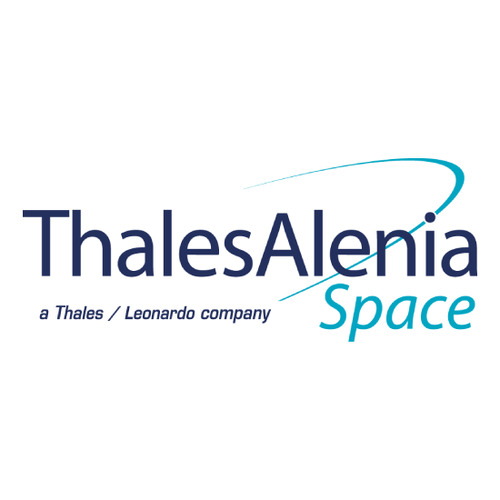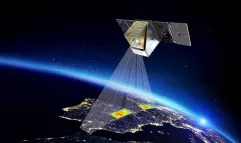Cannes, June 30th, 2025 – Thales Alenia Space, the joint venture between Thales (67%) and Leonardo (33%), has been selected by the French space agency CNES, as part of the space component of the France 2030 program launched by the French government, to develop a very-high-throughput laser communications demonstrator.
Called SOLiS — for Service Optique de Liaisons Spatiales Sécurisées (secure optical space link service) — this project aims to demonstrate the technical and economic viability of an optical communications service relying on geostationary satellites.

SOLiS © Thales Alenia Space/ E.Briot
Such a service is designed to make intercontinental networks more resilient at a time when there is a growing number of acts of sabotage targeting land and undersea optical fiber links. Geostationary satellites offer an effective and cost-effective solution for ultra-secure transfers of large amounts of data between two users on Earth, delivering very high data rates of up to one terabit per second despite distances and atmospheric disturbances.
SOLiS harnesses technologies developed through the government-backed Optical Communications (CO-OP) project led by CNES and a group of 17 SMEs and large primes, and draws on the outcomes of demonstrations delivered for the VERTIGO project funded by the European Commission.
Thales Alenia Space will lead the SOLiS project consortium, composed of large industry primes and mid-tier firms (Safran Data Systems, Bertin Technologies, Exail, Keopsys), SMEs (Cedrat Technologies), startups (OGS Technologies, Reuniwatt), and a research center (ONERA), most of which have already worked on the CO-OP project.
SOLiS plans to develop an optical communications payload and a pilot ground station designed to demonstrate very-high-throughput laser communications. In accordance with a memorandum of understanding between Thales Alenia Space and operator Hellas Sat signed in 2024, this payload will be flown on the Hellas Sat 5 geostationary communications satellite, while the pilot ground station will be set up at the operator’s teleport in Cyprus. This station will communicate with CNES’s FROGS station already operating at the Côte d’Azur Observatory on the Mediterranean coast.
Building on the accomplishments of the CO-OP project, SOLiS will put French manufacturers — large primes, mid-tier firms, SMEs, and startups — at the forefront in space communications for the 2030s as they strive to address the challenges of security, resilience, fast data rates, and multi-orbit interoperability (between the ground, constellations, and geostationary satellites).
“We are delighted to be starting development of the payload for the optical communications system, marking a crucial step toward establishing a secure, very-high-throughput optical network,” said Alcino De Sousa, Executive VP, Telecommunications at Thales Alenia Space. “Satellite laser communications projects like SOLiS are set to usher in a new era in telecommunications services, driving development of multi-orbit communications networks.”
About free-space optics
Free-space optics (FSO) is fast becoming the standard for data transmission in space, offering far superior transmission speeds on the order of one terabit per second compared to a few tens of gigabits per second with current satellite communications systems. This technology is expected to revolutionize space communications infrastructures, in the same way that optical fiber has transformed communications here on Earth.
The European Commission’s VERTIGO project, and CNES’s CO-OP, DYSCO (Démonstration et sYstème SatCom Optique), and now SOLiS projects are focused on research and development, seeking to demonstrate very-high-data-rate space optical links transmitting through the atmosphere to connect a multitude of users via multiple orbits, ground facilities, and applications.
These developments show that optical communications technology is a good fit for a range of end-to-end applications, including universal Internet access, direct and permanent data transmission from Earth-observation satellites, private links to data centers, and backup for terrestrial optical fiber in the event of a crisis.
By reducing the number of satellites required, free-space optics will help to make orbital infrastructures more sustainable while curbing space clutter.
About Thales Alenia Space
Drawing on over 40 years of experience and a unique combination of skills, expertise and cultures, Thales Alenia Space delivers cost-effective solutions for telecommunications, navigation, Earth observation, environmental monitoring, exploration, science and orbital infrastructures. Governments and private industry alike count on Thales Alenia Space to design satellite-based systems that provide anytime, anywhere connections and positioning, monitor our planet, enhance management of its resources, and explore our Solar System and beyond. Thales Alenia Space sees space as a new horizon, helping to build a better, more sustainable life on Earth. A joint venture between Thales (67%) and Leonardo (33%), Thales Alenia Space also teams up with Telespazio to form the Space Alliance, which offers a complete range of solutions including services. Thales Alenia Space posted consolidated revenues of €2.23 billion in 2024 and has more than 8,100 employees in 7 countries with 15 sites in Europe.


